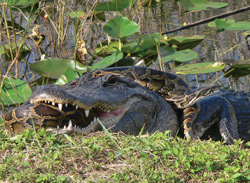|
|
“Judas Snakes” Betray Unwanted Pythonsdownloadable pdf
Removing gigantic pythons from a place they’re not wanted is no easy feat, but UF researchers have found a high-tech way to make it easier — they’re sending radio-tracked pythons out into Everglades National Park to do the work for them. Frank Mazzotti, an associate professor with UF’s Institute of Food and Agricultural Sciences, leads a team using “Judas snakes” to lure — and catch — other Burmese pythons in the park, where they’re not welcome. Pythons, which can grow longer than 20 feet and weigh more than 200 pounds, are released in the park by pet owners who don’t want or can’t handle them anymore. They’ve been causing problems in the park since the mid 1990s — their battles with native alligators the most widely documented. While a python has the strength to overpower a human, Mazzotti says he believes they pose a far bigger risk to people who hit the snakes with their cars or crash trying to avoid one. “Python attacks are not impossible, but I’d say that someone driving a Honda Civic who hits a 14-foot, 100-pound python is more likely to have a serious problem,” he said. Last winter, researchers caught four snakes, implanted pinkie-sized radio transmitters in them, tagged them and turned them loose in the park. Then for three months, the scientists kept tabs on the snakes’ whereabouts, using them to find other pythons. Three of the four original snitch snakes helped researchers find 15 more untagged snakes — 12 of which were caught and euthanized. The fourth Judas snake had trouble with stitches from the implanted transmitters and was removed from the study. The Burmese python is one of the world’s largest snake species. One of the snakes found in the Everglades was 16 feet long and 152 pounds. Everglades wildlife biologist Skip Snow said the behemoth snakes must be removed because they disrupt the park’s natural order. They’ll eat anything from gray squirrels to bobcats, he said, and they’re a direct threat to park officials’ attempts to restore some native species — such as wading birds and round-tailed muskrats — to the park. Park officials have either caught or found the remains of more than 212 pythons, 95 of them in 2005. During the December 2005 to March 2006 experiment — believed to be the pythons’ breeding season — researchers learned that the snakes had moved anywhere from hundreds of meters to more than a kilometer from where they’d been caught, often making homes in elevated forest areas. They learned that the snakes do find each other in the wild. And they learned they could indeed recapture the snakes, using transmitters’ beeps to zero in on their location.
Frank Mazzotti, fjma@ufl.edu |

